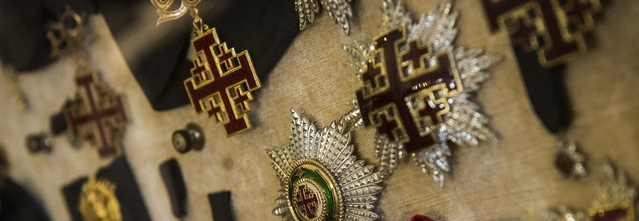
The historical origins of the Order are somewhat obscure, although according to an undocumented tradition they are traced back to the First Crusade. In fact, the first documentary evidence of an investiture of Knights referred to as "of the Holy Sepulchre" dates to 1336. Since this first testament to the Order's existence, that is, from the XIV century, the popes gradually and regularly expressed their desire to juridically annex the organization to the Holy See.
The Equestrian Order of the Holy Sepulchre of Jerusalem has always benefited from the protection of the Popes who, over the centuries, have reorganized it, augmenting and enriching its privileges. Clement VI entrusted custody of the Holy Sepulchre to the Franciscan friars in 1342, but that was still during an era when Knights alone had the right to create other members of the Order. Alexander VI declared himself the supreme moderator of the Order in 1496, and delegated to the Franciscans the power to bestow a knighthood upon nobles and gentlemen pilgrims on pilgrimage to the Holy Land (power of investiture). Confirmation of this Franciscan privilege, either verbally or by papal Bull, was renewed by Pope Leo X in 1516, by Benedict XIV in 1746, until the restoration of the Latin Patriarchate of Jerusalem by Pius IX in 1847.
Thus the pontifical delegation was transferred to the Patriarch when, in 1868, Pius IX issued Apostolic letters announcing the restoration of the Order. The Order of Knights opened up with the appointment of the Dames of the Holy Sepulcher thanks to Leo XIII, in 1888. Moreover, in 1907 Pius X decided that the title of Grand Master of the Order would be reserved to the Pope himself.
In 1932 Pius XI approved the new Constitution and permitted Knights and Dames to receive their investiture in their places of origin and not only in Jerusalem. In 1940, Pius XII named a cardinal as Protector of the Order and centralized the organization in Rome, as part of the Grand Magisterium, transferring the title of Grand Master to Cardinal Canali. John XXIII approved the new Constitution presented by Cardinal Tisserant in 1962.
With the renewal of the Second Vatican Council, a new Constitution was approved by Paul VI in 1977. Following this, John Paul II made the Order a legal canonical and public personality, constituted by the Holy See. Today the Order seeks to garner the commitment of its members in local churches hopeful for their sanctification. This is the essential and profound reason that motivated the revision of the Constitution during the "Consulta" that took place in 2013.
